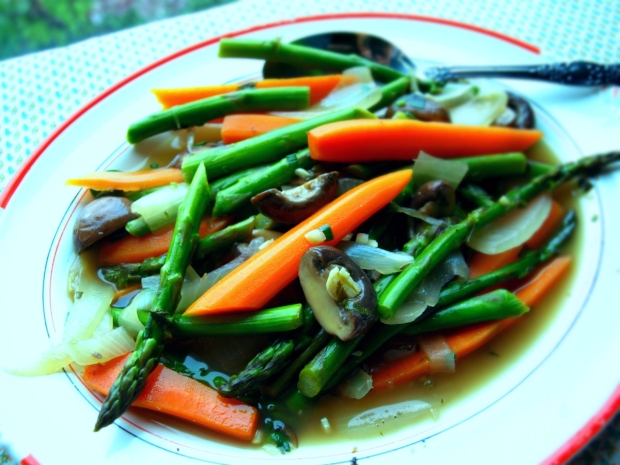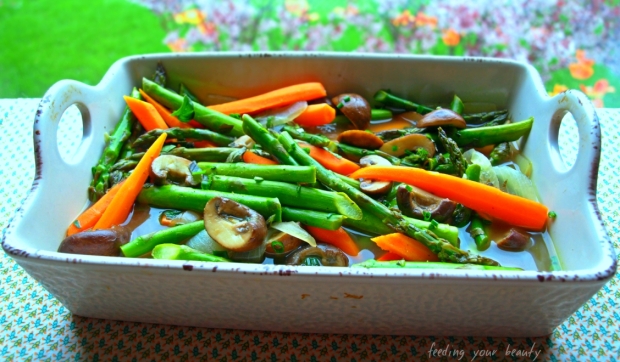
When it comes to cooking with fresh spring vegetables, sometimes simple is better. Carrots, mushrooms, and asparagus are already so flavorful, all it takes is a few simple additions to really make them shine. For this dish, these veggies are “sauced” up with a bit of wine and broth and enhanced with garlic and fresh herbs. The result is a sophisticated but simple side dish equally perfect for a spring dinner to-do, or a Tuesday night.
Last weekend, I was fortunate to be able to spend a couple of days visiting my family for Mother’s Day. I had the pleasure of helping prepare dinner for my parents and an aunt who I don’t get to see very often, so it was an extra-special and fun evening. I was excited to have the opportunity to try out this recipe on three other adults, each with differing tastes and diets. The dish got rave reviews and the serving platter was scooped right clean, always a good sign. Even my picky toddler loved munching on the tender, broth-y veggies.

The star of this dish, for me, is the asparagus. I just love asparagus, especially when it is fresh and in season. I grew up eating the freshest asparagus, since it grew right in our back yard. It still grows there, and I am lucky to take home plenty of just-picked asparagus each spring when I visit my parents. Although I’m partial to a quick asparagus saute with garlic, I’m always looking for more ways to prepare it. This recipe is definitely going on my asparagus go-to list.
Asparagus is teeming with nutrients and beneficial properties, putting it up there on the must-have list of foods for vibrant health. Below are just a few of the impressive benefits of this power plant.
Nutrient-Dense, Vitamin-Rich
Asparagus is low in calories (40 cal per cup) and high in nutrients. It is especially high in vitamin K, folate, copper, vitamin B1, selenium, vitamin B2, vitamin C, and vitamin E. Folate is especially important for preventing birth defects, and should be consumed both during pregnancy as well as pre-conception by both mom and dad. Folate also works with vitamin B-12, and together these two help prevent cognitive decline and memory loss. It is also a good source of zinc, iron, protein, and soluble and insoluble fiber.
Antioxidant and Anti-Inflammatory
Asparagus contains an array of anti-inflammatory compounds, including saponins, which have been studied for their ability to reduce chronic diseases and may be helpful in treating the neurodegenerative disease ALS (or Lou Gehrig’s Disease). Asparagus also contains a variety of antioxidants, which we now know are the body’s best defense against disease and premature aging. Most notably, asparagus contains glutathione, which has been referred to as the “mother of all antioxidants.” A discussion on glutathione could easily take up several blog posts, but just know it is important in slowing down the aging process, preventing chronic diseases as well as keeping skin young and firm.
Digestive Support and Disease Prevention
Asparagus has recently been studied for it’s benefits to digestive health. Asparagus contains inulin, which is sometimes referred to as a “pre-biotic,” a carbohydrate that remains intact until it reaches the large intestine, where it provides food for healthy bacteria. In addition to inulin, asparagus also contains a good amount of protein (4-5 grams per cup) plus fiber (3 grams per cup) which help keep digestion at an optimal rate. Stabilizing our digestion helps us absorb nutrients better, and keep our energy levels consistent. Due to its impressive content of B vitamins, as well soluble fiber, asparagus intake has been shown to decrease our risk of heart disease, as well as type 2 diabetes.
I came across many other interesting uses and benefits of asparagus including: treatment of urinary tract infections (asparagus is a natural diuretic), prevention of kidney stones and anemia, hormonal imbalances in women, constipation, nerve pain, natural aphrodisiac, and clearing acne (some folks swear by cleansing the face with it. It’s even one of the main ingredients in the Ayesha Fresh Face Mask from Lush).
I may have to consider a homemade asparagus face mask for the future. For now I think I will continue to enjoy this vegetable by stuffing it into my face, instead of slathering it on. Oops… when I say “stuffing into my face”, I mean daintily piercing them with a fork and gracefully nibbling them up. After all, it is an “elegant” side dish. I’ll try to show some restraint.
Saucy Spring Vegetables
Adapted from this recipe from Better Homes and Gardens
prep time: 10 minutes cook time: 15 minutes
Makes about 4 servings
- 3 large carrots, peeled and halved or quartered if very large, and cut into 3-4 inch pieces
- 8 oz. baby bella mushrooms, or other mushroom of choice, halved
- 1 lb of fresh asparagus, washed and woody stems trimmed, large stalks can be cut in half
- 1/2 large sweet onion, sliced
- 1 Tbsp. Unrefined Coconut Oil
- 3/4 cup white wine
- 3/4 cup vegetable broth
- 2 large garlic cloves, minced
- 2 Tbsp of fresh oregano, or other fresh herb of choice, divided
- 1/4 tsp salt
- 1/4 tsp pepper
Directions:
1. Heat a large skillet over medium heat, melt coconut oil, then add carrots, mushrooms, onions, and garlic. Saute for a few minutes.
2. Increase the heat to medium high and add the wine. Cook for a few minutes, then add the vegetable broth, salt, pepper, and half of the fresh herbs. Cook until veggies are crisp-tender (5-8 minutes).
3. Turn the heat down to medium, then add the asparagus. Cook for just a few minutes. Asparagus should turn bright green and be crisp-tender. Sprinkle with remaining herbs and a little fresh pepper, and serve.
this looks absolutely delicious!!!
https://aspoonfulofnature.wordpress.com/
LikeLike
Thank you so much 🙂
LikeLiked by 1 person
I really like this combination of veggies! Sounds delicious 🙂
http://www.thegreenbowl.at
LikeLike
Thank you! it’s definitely one of my favorite simple veggie dishes!
LikeLike
Reblogged this on Cinnamon Ginger Tea.
LikeLiked by 1 person